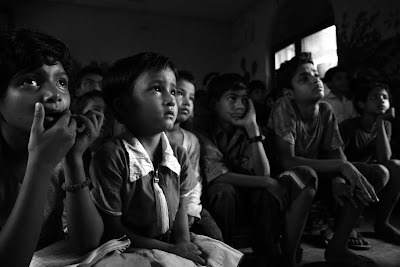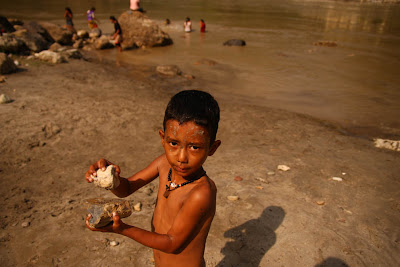I’ve got a fantastic photographer to share with you this month. Our November Photographer of the Month is Jessica Lehrman. She spent part of this summer in India, volunteering at an orphanage. She’s a student at SUNY Purchase, a world traveler, and an extraordinary photographer. We were lucky enough to sit down and chat with Jessica – here’s what she had to say…


WE: How did you get interested in photography?
JL: I actually discovered photography by mistake, well, it was more like divine intervention. My junior year of high school I attended the Rhode Island School of Design’s summer pre-college program hoping to study painting and drawing. Unfortunately for me at the time, I signed up so late that I was placed in the traditional photography major. That was my 4th choice and my top 3 options had already been filled. I had never spoken the word "aperture" before and I spent my first hour in class at RISD trying to figure out how to take off my lens cap. By the second day of intensive photography classes I was a complete addict and had to be dragged out of the darkroom after a 10-hour stint of printing attempts and developer room dance parties.
Nothing has since changed, and I believe I was definitely meant to "accidentally" not become a painter.
Although I used to dream in colorful acrylics, photography has seeped into crevices of my life that paint never infiltrated. The camera lens has become more of an extension of me than a paintbrush ever was. It not only provides an artistic means, but a voice that transcends past languages and cultures, And I am driven to use this voice to awaken people to a world around them they might have missed, an issue they can help transform, or a place that needs their help. Since my first introduction to the world of photography at RISD, I've fallen in love with what I see through my lens, and expect this to be a love affair that lasts a lifetime. (That came out a bit sappier than intended, but you catch my drift..)


WE: How long have you been a photographer?
JL: Now that I think about it, really only 3 years. I guess I'm quite a newbie then, aren't I? I've been an artist since I was able to hold a paintbrush or smear charcoals all over my walls, so I’ve been creating for some time, but photography is a pretty recent innovation in the evolution of my career... well, after belly dancing and rapping, but those two paths failed due to lack of talent.



WE: What is your favorite place to photograph? Or subject?
JL: Place becomes pretty secondary to the subjects I shoot. On one hand, I am completely head over heels in love with and fascinated with photographing people; the exterior world outside of my subject’s face is ultimately interchangeable as long as I have an interesting person to capture. I find everything about people to be beautiful and interesting in its own different and unique way.
On the other hand, when I'm able to capture something revealing about the relationship between the person and their environment I'm even more ecstatic; I feel like I've "done my job".
I've tried to shoot mountains and cityscapes and those fluffy little flowers that look really magical during dusk, but in the end, without a person in my shot, I get disinterested. I am particularly interested in the journalistic aspects of photography, and would consider most of my work to be on the documentary side. I like to think my work lives in that area where aesthetics and message overlap, where art and story dance together.
That being said, I think my favorite places to shoot, or people to shoot, are those with stories, maybe in the lines of their face or their personal surroundings. My favorite photographs are the ones that tell a tale of a life having really been lived - in a remote village in Nicaragua, on the street in Delhi, the look of love between a families, a story that conveys anger, hope, oppression, ecstasy. Capturing a person's real story, I want to bring you into the world of the image. If I can take a photo like that, I feel I've done my job.



WE: How can photographers help change/impact the world, while they are traveling?
JL: This is a really good question, and I want to take it more literally than figuratively, so I made a To-Do list.
Ways To Change The World Through Photography
1) Develop Revolutionary Sensitivity
Think about your relationship to the world and what matters to you. Then consider your camera and your relationship to it. Is it a toy or a tool? You are a traveler and you have a camera. Practice thinking in terms of being the one who enables your camera to bring to the world at large what matters in the little worlds of your travels.
2) Be a Photojournalist
Use your images to document something you feel needs to be highlighted but doesn’t have representation. If a tree falls in the forest and no one is there to hear it, does it make a sound? Well, maybe not. But if you happen to be in a tiny corner of the global forest where a sound needs to be heard, make the sound echo by taking a picture. The photographic image can be a very powerful means to awaken others to issues that words cannot express. Change the world through this awakening.
3) Share
The simple act of being excited about your travels can encourage others to also strive to experience new cultures. Bring your photographs home, post them on your blog, inspire others to travel - and to volunteer. By showing them places you've been and new experiences you've captured you're helping to weaken the gates that separate and restrict understanding.
4) Teach
Find an area that is lacking arts education or after school programs where you are traveling to and organize a photography class with donated cameras and film. Inspire kids to document their world through their lens, and influence a next wave of conscious photojournalists.
5) Collaborate and Contribute
Donate your photography services to a non-profit organization related to where you will be going. Find a charity that needs press photos, an orphanage that could use portraits for a calendar to raise needed funds. Be creative about ways to connect with already existing organizations to help them boost their image or increase donations.
6) Sell Photographs for Charity
If you already have a website, or if you want to sell your work in a gallery, have the proceeds go towards the people in your photographs or a group from that geographical region.
There are many other ways to make your traveling experience a conscious trip infused with an intention to transform the world through your photography, but these are just some I think would be super fun.
You could also:
Make a photo book that teaches readers about the area you traveled to and donate the proceeds,
Travel with a journalist who needs photos for his or her stories,
Shoot pictures for a magazine already making a difference,
Teach child soldiers how to use a camera instead of a gun,
Start a photo blog that takes donations for selected organizations...


WE: Are there rules in other countries people need to be aware of about who or what you can or cannot shoot?
JL: Definitely, in fact after being chased down the street by 4 bikers with spike bracelets who saw me photograph their passed out friend, the first photo I ever took taught me this lesson, and that was in the US. I would say that there isn't a general rule about photography etiquette country to country, but I would recommend asking locals when you arrive somewhere on religions or customs. When I was in India I had strangers begging to be in photographs, which surprised me because I had heard in the US that no one would let me take pictures in India because it is against customs. Photographing people can be a very intense experience if you have any issues with confrontation. I struggled in Central America with ways to approach the issue. I think it's a general rule in most countries that you should ask before taking pictures of children and that if you are taking a portrait of someone, be polite and ask instead of running up and running away. I personally like the un-posed look more so I tend to first shoot and then ask, but this method might not work if you don't look like an innocent 12-year-old girl such as myself.



WE: Any tips you want to share?
JL: Anything you want to do in life, just do it. Not to sound like a sing songy version of a Nike slogan, but... I feel very strongly that if you want to be a photographer, you already are, and go for it.
We are living in an incredibly exciting time of super connection and instant exchange of information with the boom of new media and social networking. I think now more than ever, artists are able to be seen and be heard. If I had one tip it would be to make the message that you send through your work be one of peace, global understanding, and acceptance.



WE: Is there anything else you'd like to share with us?
JL: Maybe just to stress the importance of connecting with others - before traveling to research sites like this one, and to look into what world is you're about to enter. And when traveling, to connect with both other travelers and the local folk - as well as keeping those connections going afterward. Photography can help there, too. I can't remember how many people I've taken pictures of, gotten their mailing information, and joyfully sent prints to after I got home. Everybody wins.


WE: Thanks so very much, Jessica. Your work is extraordinary!

All photos courtesy and copyright Jessica Lehrman.
